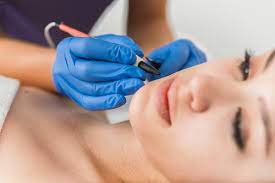What’s the Science Behind Laser Hair Removal?

Unwanted hair can be a persistent concern, and traditional methods like shaving or waxing only offer short-term solutions. That’s why many individuals are turning to laser hair removal, a treatment that offers precision, long-lasting results, and clinical reliability. But what truly makes this treatment effective? The answer lies in its scientific foundation. Laser hair removal uses focused beams of light to target hair follicles at their root, a process that disrupts their growth cycle without damaging the surrounding skin. This advanced technology has been refined by medical professionals to provide accurate, safe, and efficient hair reduction. If you're considering permanent hair reduction, it's worth understanding the science that makes it work—especially when receiving Laser Hair Removal in Dubai under expert medical supervision.
How Laser Hair Removal Works: The Scientific Process
Laser hair removal operates on the principle of selective photothermolysis. This means the laser targets a specific chromophore—in this case, melanin, the pigment in hair—without affecting the surrounding tissues. The laser emits a specific wavelength of light that is absorbed by the melanin in the hair shaft. This light is converted into heat, which then damages the hair follicle and inhibits its ability to regrow hair.
What makes this technique so effective is its precision. Each laser pulse lasts only a fraction of a second but can treat many hairs at once. Doctors customize the treatment settings based on the patient’s hair color, skin tone, and the treatment area to ensure maximum safety and efficacy.
Role of Melanin and Light Energy in Targeting Hair Follicles
Melanin plays a vital role in absorbing the laser's energy. Since darker hair contains more melanin, it absorbs more laser energy, making the treatment especially effective on individuals with high contrast between their skin tone and hair color. The absorbed energy heats the hair follicle enough to impair its growth cycle.
Doctors use various types of lasers depending on the patient's skin type and hair characteristics. For instance, Nd:YAG lasers are ideal for darker skin tones, while Alexandrite and Diode lasers are commonly used for lighter skin. This variation ensures that melanin in the skin isn’t excessively targeted, reducing the risk of pigmentation issues while focusing solely on the follicle.
Hair Growth Cycle: Why Multiple Sessions Are Required
Hair grows in three phases: anagen (growth phase), catagen (transitional phase), and telogen (resting phase). Laser hair removal is only effective during the anagen phase when the hair is actively growing and still attached to the follicle.
Since not all hairs are in the anagen phase simultaneously, multiple sessions are necessary to effectively target and disable most hair follicles. During treatment planning, doctors typically space sessions 4–6 weeks apart to align with the natural hair growth cycles of different areas.
Precision Treatment Guided by Advanced Technologies
Modern laser systems come with real-time monitoring and cooling mechanisms that make the procedure more comfortable and highly targeted. These features are especially critical when working in delicate areas like the face, bikini line, or underarms.
Doctors adjust parameters such as fluence (energy per square centimeter), pulse duration, and spot size to match the treatment area. For instance, a larger spot size may be used for areas like the back or legs, whereas a smaller, more focused beam is ideal for facial regions. This tailored approach ensures each patient receives optimal treatment suited to their unique hair and skin profile.
Professional Approach by Trained Specialists
Laser hair removal should always be conducted by experienced medical professionals who understand skin physiology and laser physics. Before starting treatment, doctors perform a thorough consultation and often conduct a patch test to determine how your skin responds to laser exposure.
They evaluate factors such as skin tone, hair density, medical history, and previous hair removal methods. This evaluation allows for a personalized treatment plan that enhances safety and optimizes results. Professionals also ensure that laser parameters are set to avoid overheating or insufficient energy delivery, maintaining a balance between efficacy and comfort.
Realistic Expectations and Long-Term Outcomes
Laser hair removal does not guarantee 100% permanent hair elimination but offers significant, long-term hair reduction. Most patients experience 80–90% reduction in hair after completing their treatment plan. The remaining hair is often finer, lighter, and grows much slower than before.
Doctors typically recommend maintenance sessions once or twice a year after the initial treatment series. These sessions help to catch any dormant follicles that may become active and ensure consistent, smooth results over time.
Body Areas Commonly Treated with Laser Hair Removal
Laser hair removal is versatile and effective across various areas of the body. Some of the most commonly treated regions include:
Face: Upper lip, chin, and jawline.
Arms & Underarms: Precision treatment with smoother outcomes.
Legs: Full legs or lower half for long-lasting smoothness.
Back & Chest: Popular among men seeking hair reduction.
Bikini Line: A highly requested area for both comfort and aesthetics.
Doctors assess skin sensitivity in each area and adapt the settings to ensure comfortable and effective outcomes across these regions.
Benefits of Laser Hair Removal
The medical advantages and lifestyle improvements of laser hair removal are numerous. Here’s a breakdown of the most prominent benefits offered by this advanced treatment:
Long-Lasting Results: Unlike temporary methods, laser treatment offers semi-permanent to permanent reduction, eliminating the need for daily or weekly grooming.
Precision and Accuracy: Lasers target dark, coarse hairs while leaving the surrounding skin untouched. This level of accuracy is hard to achieve with any other method.
Time Efficiency: Each laser pulse treats multiple hairs in milliseconds. Small areas like the upper lip can be treated in under a minute.
Smooth Skin Texture: Consistent treatments often lead to smoother skin by reducing ingrown hairs and bumps.
Minimal Discomfort: Thanks to built-in cooling mechanisms and professional handling, discomfort is minimal and brief.
These benefits are greatly enhanced when performed by experienced doctors using advanced, clinically tested equipment in a professional setting.
Advanced Laser Equipment Used by Professionals
Medical-grade laser devices used by trained practitioners offer superior performance and safety. These include:
Diode Laser Systems: Ideal for fair to medium skin tones with coarse hair.
Alexandrite Laser: Fast treatment for larger areas with lighter skin.
Nd:YAG Laser: The safest choice for darker skin tones due to its deeper penetration and minimal melanin absorption in the skin.
Doctors choose equipment based on the individual's specific skin and hair profile. They continuously calibrate the settings to adapt to the patient’s response over multiple sessions, ensuring effective and consistent results.
Importance of Medical Consultation Before Treatment
An essential part of laser hair removal is the initial consultation. During this session, the doctor:
Assesses the skin and hair type.
Reviews any underlying medical conditions or skin concerns.
Performs a patch test to check laser compatibility.
Designs a tailored treatment schedule.
A proper consultation ensures that the patient is a suitable candidate and that the treatment plan aligns with their unique goals. It also allows the doctor to set realistic expectations about the outcome and timelines.
After-Treatment Care: Medical Supervision is Key
After each session, patients are provided with clear post-care instructions by their doctors. This typically includes guidelines on sun exposure, skincare products, and follow-up schedules. Continuous follow-ups ensure that results are progressing as expected and that any necessary adjustments can be made to treatment parameters.
Doctors monitor the skin’s reaction over time and provide professional care advice to maintain long-term results without complications. This is another reason why medical supervision is vital for safe and successful laser hair removal.
Conclusion:
Laser hair removal is more than just a cosmetic procedure—it's a scientifically developed, medically executed treatment that offers long-term relief from unwanted hair. With its foundation in precise light-based technology, and its delivery by trained professionals, the treatment stands out as one of the most effective methods for sustained hair reduction. Understanding the science behind it helps you make informed decisions and sets realistic expectations for outcomes. For patients seeking advanced and safe hair reduction solutions, there’s no better place to experience this than with professional Laser Hair Removal in Dubai.
Note: IndiBlogHub features both user-submitted and editorial content. We do not verify third-party contributions. Read our Disclaimer and Privacy Policyfor details.







